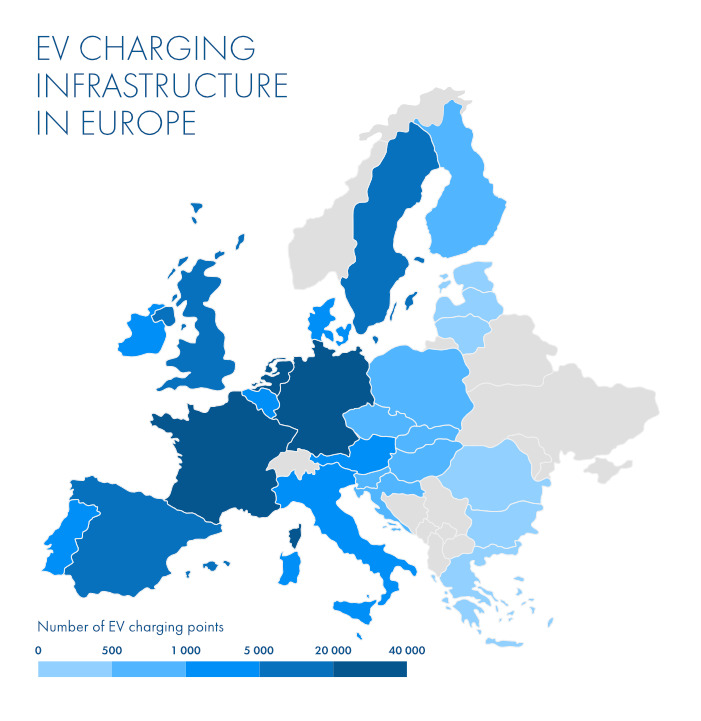Europe offers a wide range of amazing destinations for a road trip and relatively good infrastructure to drive across the countries. But what if you’re an environmentally conscious traveller who drives an electric car? Using an electric vehicle for long journeys around Europe may seem a bit adventurous but it’s not that difficult anymore.
Below you’ll find a few tips when it comes to the EV you may choose, the equipment you will need, and a road trip route suggestion on the West coast of Europe through lesser known regions of western France and northern Spain. So whenever the warmer weather comes back, power up and get moving!
Which car?
The choice of your vehicle depends on how much driving you want to do on a daily basis. In general, Tesla will give you the possibility of very fast charging and a wider range than other brands but they have a price tag to match.
If your intention is to drive from city to city in Europe pretty much any EV will do – the newer models have better and better ranges, even up to 295 miles (about 500 km) for the VW ID.3. This is more than enough for an average trip involving bigger cities in Spain or France. Remember, though, that as you will probably have a lot of luggage your range may be reduced (same as with a petrol car). So do charge as often as possible.
Not all electric cars are equal, however, with some models including a range-extending internal combustion engine or hybrid drivetrain. Learn more about the various types of electric vehicles below:

Where to charge?
You can always check a comprehensive map of charging stations on chargemap.com (or your car manufacturer’s app), but take into account that large cities are safe milestones.
In general, while the north or Europe is usually very well equipped (Germany, Netherlands, France), in countries like Greece, Southern Italy and Poland, the EV charging infrastructure is poorer. Therefore, consider planning ahead and maybe adjusting your destination (and stops) accordingly. Also, check your assistance options – be careful as AAA has recently suspended their electric assistance, possibly because charging stations are now frequent enough.

Map source: 2019 in the Automotive Industry
In-car equipment
What you must have in a standard vehicle across Europe is mostly fixed. The obligatory car equipment usually includes a reflective jacket, first aid kit, one warning triangle (in some places two), and a fire extinguisher. A few details may vary from country to country, for example the requirements regarding spare bulb sets or safety kits.
With an electric vehicle you will need a Class E extinguisher (for electric fires). So once you have also packed a portable, adjustable rate EVSE cable (it is not mandatory, but strongly recommended) you are good to go.
The route on the wetter side
This road trip should take you 5 to 6 days as it includes a lot of sightseeing. On the first leg, from Calais to Oviedo, charging stations will be easy to find. Charging stations in the second leg, from Oviedo to Santiago de Compostela, are more rare so you will require a full charge leaving Oviedo and a recharge as soon as you arrive in A Coruna.
Start with the Shuttle and head straight west, following the Atlantic coast into Normandy and D-Day beaches. On the following day, Mont Saint-Michel and then south to the raised stones of Brittany. Stop for a nice bowl of Breton cider and buckwheat pancake. After you have seen the historical walls of Nantes, we invite you to proceed to the wine vineyards of Bordeaux and Aquitaine, a region of France which was once owned by the English Crown.

Carry on south to the posh seaside resort of Biarritz, enjoy a dish of chicken basquaise (spicy tomato and vegetable sauce) with a slice of Basque cheese, watch a game of Basque pelota and cross the border into Euskera, the Basque country. Spend a day and see the extravagant architecture of the Bilbao Guggenheim museum. Enjoy a crazy night in Bilbao, walk the narrow streets at night among the partying locals (they go out almost every day of the week), and get an informal bite in the small tapas bars of this vibrant city. If you forgot to pack a raincoat, this is where you will buy it.
Along the northern coast of Spain you will discover the charm of a region wetter than England, green and a world apart from the touristy Costa Brava. In Asturias and its charming capital Oviedo, you will discover the Celtic heart of Spain, which is very similar to Ireland in many ways. There you will see probably for the first time horreos (granaries built on stone pillars), and we hope you try the typical dishes of this authentic region, especially the bean and sausage stew named fabada. If your finances allow, stay at Hotel de la Reconquista in Oviedo. This is where the Prince of Asturias stays when he visits the city.
Follow the setting sun, and carry on the path of the pilgrims of Compostela, all the way on the rugged coast that will take you to A Coruna, its renowned octopus and seafood dishes and the coast of Portugal. You can now go north back to Poole with the ferry (from Gijon, Asturias) or to sunnier skies into Portugal and Andalucia. The choice is yours.

